
Bryan Lunney (born January 12, 1966) is an American aerospace engineer and former NASA flight director.

Bryan Lunney (born January 12, 1966) is an American aerospace engineer and former NASA flight director.
The son of Apollo-era flight director Glynn Lunney (1936–2021), [1] Bryan Lunney grew up in Friendswood, Texas, and attended Friendswood High School. He graduated from Texas A&M University in 1988 with a Bachelor of Science degree in Aerospace Engineering. [2]
After graduation, Lunney took a job at NASA's Johnson Space Center. He worked in Mission Control as a Propulsion Engineer before moving to become head of the Motion Control Systems Group, a flight control position associated with the International Space Station. [2] At the time of his father's death in 2021, they were the first and only multi-generational flight directors to have served NASA. [3]
In January, 2001, Lunney was appointed a flight director. [2] He was on duty during the Expedition 4 mission when the International Space Station's computers failed, leaving the station's gyroscopes without the information they needed in order to hold the station's attitude stable. Lunney led controllers in creating a primitive but effective temporary solution to the problem, having the crew control the attitude of the space station based on their observations of the Sun's position. He said later that “I felt like a fireman who’d walked out of a burning house having just rescued the kids from the bedroom.” [4]
Lunney also worked as a flight director on Expedition 11, and as the Planning/Orbit 3 flight director on the STS-115 mission in September 2006. [5]
Lunney and his wife, the former Amori Syptak, have three children, Christopher, Macy, and Drake.
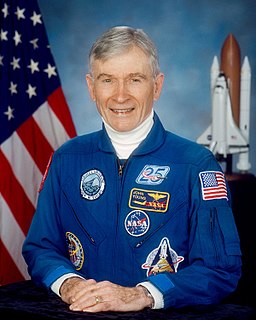
John Watts Young was an American astronaut, naval officer and aviator, test pilot, and aeronautical engineer. He became the ninth person to walk on the Moon as commander of the Apollo 16 mission in 1972. He flew on four different classes of spacecraft: Gemini, the Apollo command and service module, the Apollo Lunar Module, and the Space Shuttle.
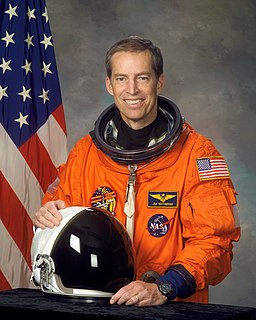
James Donald "Wxb" Wetherbee, is a retired United States Navy officer and aviator, test pilot, aerospace engineer, and NASA astronaut. He is a veteran of six Space Shuttle missions and is the only American to have commanded five spaceflight missions.
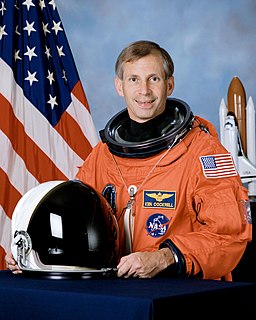
Kenneth Dale "Taco" Cockrell is a retired American astronaut, engineer and a veteran of five Space Shuttle missions. He served as Chief of the Astronaut Office from 1997 to 1998.
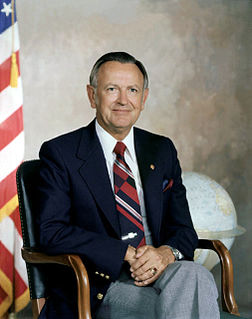
Christopher Columbus Kraft Jr. was an American aerospace engineer and NASA engineer and manager who was instrumental in establishing the agency's Mission Control operation. Following his graduation from Virginia Polytechnic Institute and State University in 1944, Kraft was hired by the National Advisory Committee for Aeronautics (NACA), the predecessor organization to the National Aeronautics and Space Administration (NASA). He worked for over a decade in aeronautical research before being asked in 1958 to join the Space Task Group, a small team entrusted with the responsibility of putting America's first man in space. Assigned to the flight operations division, Kraft became NASA's first flight director. He was on duty during such historic missions as America's first crewed spaceflight, first crewed orbital flight, and first spacewalk.

Stephanie Diana Wilson is an American engineer and a NASA astronaut. She flew to space onboard three Space Shuttle missions, and is the second African American woman to go into space, after Mae Jemison. Her 42 days in space are the most of any female African American astronaut.
Space Shuttle missions designated STS-3xx were rescue missions which would have been mounted to rescue the crew of a Space Shuttle if their vehicle was damaged and deemed unable to make a successful reentry. Such a mission would have been flown if Mission Control determined that the heat shielding tiles and reinforced carbon-carbon panels of a currently flying orbiter were damaged beyond the repair capabilities of the available on-orbit repair methods. These missions were also referred to as Launch on Demand (LOD) and Contingency Shuttle Crew Support. The program was initiated following loss of Space Shuttle Columbia in 2003. No mission of this type was launched during the Space Shuttle program.
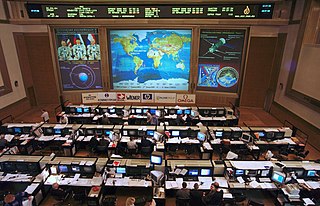
Flight controllers are personnel who aid space flight by working in such Mission Control Centers as NASA's Mission Control Center or ESA's European Space Operations Centre. Flight controllers work at computer consoles and use telemetry to monitor various technical aspects of a space mission in real time. Each controller is an expert in a specific area and constantly communicates with additional experts in the "back room". The flight director, who leads the flight controllers, monitors the activities of a team of flight controllers, and has overall responsibility for success and safety.

Clayton Conrad Anderson is a retired NASA astronaut. Launched on STS-117, he replaced Sunita Williams on June 10, 2007 as a member of the ISS Expedition 15 crew. He is currently an author, a motivational speaker, and a Professor of Practice at Iowa State University in Ames, Iowa.
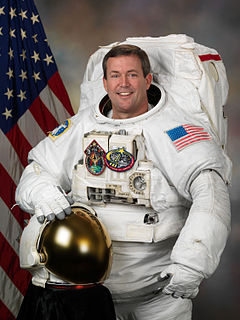
Michael James Foreman is a retired U.S. Navy pilot and a NASA astronaut. While with NASA, Foreman was part of a mission that delivered the Japanese Experiment Module and the Canadian Special Purpose Dexterous Manipulator to the International Space Station. Foreman was also a crewmember of the STS-129 mission in November 2009. In 2018, he was elected mayor of Friendswood, Texas. His wife Lorrie is a civil engineer.

John Daniel "Danny" Olivas is an American engineer and a former NASA astronaut. Olivas has flown on two space shuttle missions, STS-117 and STS-128. He performed EVAs on both missions, totaling 34hrs 28min.

STS-126 was a Space Shuttle mission to the International Space Station (ISS) flown by Space Shuttle Endeavour. The purpose of the mission, referred to as ULF2 by the ISS program, was to deliver equipment and supplies to the station, to service the Solar Alpha Rotary Joints (SARJ), and repair the problem in the starboard SARJ that had limited its use since STS-120. STS-126 launched on 14 November 2008 at 19:55:39 pm EST from Launch Pad 39A at NASA's Kennedy Space Center with no delays or issues. Endeavour successfully docked with the station on 16 November. After spending 11 days, 16 hours, and 46 minutes docked to the station, during which the crew performed four spacewalks, and transferred cargo, the orbiter undocked on 28 November 2008. Due to poor weather at Kennedy Space Center, Endeavour landed at Edwards Air Force Base on 30 November 2008 at 21:25 UTC.
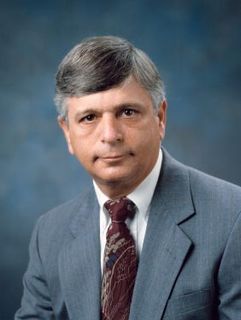
Jay Henry Greene was a NASA engineer. Between 2000 and 2004, he served as Chief Engineer at Johnson Space Center, where his role consisted primarily of advising the Center Director. He worked as a FIDO flight controller during the Apollo Program and a flight director from 1982 to 1986, and as ascent flight director during the 1986 Space Shuttle Challenger disaster.

Glynn Stephen Lunney was an American NASA engineer. An employee of NASA since its creation in 1958, Lunney was a flight director during the Gemini and Apollo programs, and was on duty during historic events such as the Apollo 11 lunar ascent and the pivotal hours of the Apollo 13 crisis. At the end of the Apollo program, he became manager of the Apollo–Soyuz Test Project, the first collaboration in spaceflight between the United States and the Soviet Union. Later, he served as manager of the Space Shuttle program before leaving NASA in 1985 and later becoming a vice president of the United Space Alliance.
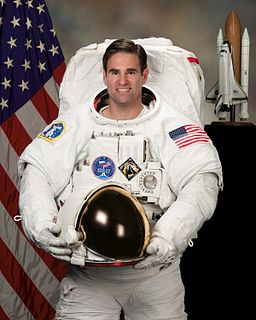
Gregory Errol Chamitoff is a Canadian-born American engineer and former NASA astronaut. He has been to space twice, spending 6 months aboard the ISS across Expedition 17 and 18 in 2008, and another 15 days as part of STS-134 in 2011. STS-134 was the last of Space Shuttle Endeavour which delivered the Alpha Magnetic Spectrometer and completed the US Orbital Segment.
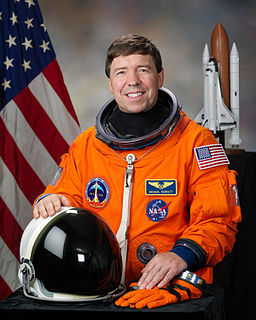
Michael Reed Barratt is an American physician and a NASA astronaut. Specializing in aerospace medicine, he served as a flight surgeon for NASA before his selection as an astronaut, and has played a role in developing NASA's space medicine programs for both the Shuttle-Mir Program and International Space Station. His first spaceflight was a long-duration mission to the International Space Station, as a Flight Engineer in the Expedition 19 and 20 crew. In March 2011, Barratt completed his second spaceflight as a crew member of STS-133.

NASA Astronaut Group 16 was a group of 44 astronauts announced by NASA on May 1, 1996. The class was nicknamed "The Sardines" for being such a large class, humorously implying that their training sessions would be as tightly packed as sardines in a can. These 44 candidates compose the largest astronaut class to date. NASA selected so many candidates in preparation for the anticipated need for ISS crew members, along with regular shuttle needs. Nine of the 44 astronauts selected were from other countries including 5 from Europe and 2 from Canada and Japan.

NASA's Christopher C. Kraft Jr. Mission Control Center, also known by its radio callsign, Houston, is the facility at the Lyndon B. Johnson Space Center in Houston, Texas, that manages flight control for America's human space program, currently involving astronauts aboard the International Space Station (ISS). The center is in Building 30 at the Johnson Space Center and is named after Christopher C. Kraft Jr., a NASA engineer and manager who was instrumental in establishing the agency's Mission Control operation, and was the first Flight Director.

NASA Astronaut Group 14 was a group of 24 astronauts announced by NASA on 31 March 1992. The group's name derived from The Muppet Show skit "Pigs in Space" and from the group's sponsorship of a pot-bellied pig at the Houston Zoo.

James Milton Heflin Jr. is a retired NASA official, who recently served as the associate director for technical activities at Johnson Space Center in Houston. Heflin also served as lead flight director for seven high-profile Space Shuttle missions, including the first to service and repair the Hubble Space Telescope and three that deployed inter-planetary probes.

Josef F. Schmid is a German-American physician, NASA flight surgeon and a major general in the United States Air Force Reserves. He served as an aquanaut on the joint NASA-NOAA NEEMO 12 underwater exploration mission in May 2007.